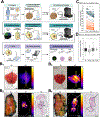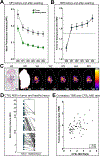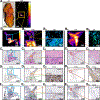Ex vivo fluorescence-guided resection margin assessment in breast cancer surgery using a topically applied, cathepsin-activatable imaging agent
- PMID: 39401538
- PMCID: PMC12318534
- DOI: 10.1016/j.phrs.2024.107464
Ex vivo fluorescence-guided resection margin assessment in breast cancer surgery using a topically applied, cathepsin-activatable imaging agent
Abstract
Up to 40 % of breast cancer patients have a tumor-positive resection margin (TPRM) - defined as cancer cells at the surface of the resected specimen - after breast-conserving surgery (BCS), necessitating re-resection or boost radiation. To prevent these additional treatments, intraoperative near-infrared (NIR) fluorescence imaging with the topically applied, cathepsin-activatable imaging agent AKRO-6qcICG might be used to detect TPRMs and guide additional resection. Here, to validate its performance, the agent is topically applied to all surfaces of freshly resected breast cancer specimens (n = 11 patients) and to 3-5 mm thick tissue slices of the specimens (n = 26 patients). NIR fluorescence images of the resection surfaces and tissue slices are acquired and correlated to final histopathology. AKRO-6qcICG detects TPRMs with a sensitivity, specificity, PVV, and NPV of 100 %, 67 %, 10 %, and 100 %, respectively. On the tissue slices, the fluorescence signal has a median tumor-to-background ratio of 1.8. These findings indicate that topically applied AKRO-6qcICG can visualize TPRMs ex vivo with a high sensitivity and NPV, with sufficient contrast to adjacent healthy breast tissue.
Keywords: Activatable probes; Breast cancer; Cathepsins; Fluorescence-guided surgery; Topical application.
Copyright © 2024 The Authors. Published by Elsevier Ltd.. All rights reserved.
Conflict of interest statement
Declaration of Competing Interest The authors declare the following financial interests/personal relationships which may be considered as potential competing interests: James P. Basilion reports financial support was provided by National Institutes of Health. Matthew Bogyo reports financial support was provided by National Institutes of Health. James P. Basilion reports a relationship with Akrotome Imaging that includes: board membership, consulting or advisory, equity or stocks, funding grants, and travel reimbursement. Matthew Bogyo reports a relationship with Akrotome Imaging that includes: board membership, consulting or advisory, equity or stocks, funding grants, and travel reimbursement. Brian Straight reports a relationship with Akrotome Imaging that includes: employment, equity or stocks, funding grants, and travel reimbursement. James P. Basilion has patent licensed to Akrotome Imaging. Matthew Bogyo has patent licensed to Akrotome Imaging. If there are other authors, they declare that they have no known competing financial interests or personal relationships that could have appeared to influence the work reported in this paper.
Figures



References
-
- Sung H, Ferlay J, Siegel RL, Laversanne M, Soerjomataram I, Jemal A, Bray F, Global Cancer Statistics 2020: GLOBOCAN Estimates of Incidence and Mortality Worldwide for 36 Cancers in 185 Countries, CA Cancer J. Clin. 71 (3) (2021) 209–249. - PubMed
-
- van Bommel AC, Spronk PE, Vrancken Peeters MT, Jager A, Lobbes M, Maduro JH, Mureau MA, Schreuder K, Smorenburg CH, Verloop J, Westenend PJ, Wouters MW, Siesling S, Tjan-Heijnen VC, van Dalen T, Audit NBC, Clinical auditing as an instrument for quality improvement in breast cancer care in the Netherlands: The national NABON Breast Cancer Audit, J. Surg. Oncol. 115 (3) (2017) 243–249. - PubMed
-
- Waks AG, Winer EP, Breast cancer treatment: a review, JAMA 321 (3) (2019) 288–300. - PubMed
-
- Clarke M, Collins R, Darby S, Davies C, Elphinstone P, Evans V, Godwin J, Gray R, Hicks C, James S, MacKinnon E, McGale P, McHugh T, Peto R, Taylor C, Wang Y, Early G Breast Cancer Trialists’ Collaborative, Effects of radiotherapy and of differences in the extent of surgery for early breast cancer on local recurrence and 15-year survival: an overview of the randomised trials, Lancet 366 (9503) (2005) 2087–2106. - PubMed
-
- Fisher B, Anderson S, Bryant J, Margolese RG, Deutsch M, Fisher ER, Jeong JH, Wolmark N, Twenty-year follow-up of a randomized trial comparing total mastectomy, lumpectomy, and lumpectomy plus irradiation for the treatment of invasive breast cancer, N. Engl. J. Med 347 (16) (2002) 1233–1241. - PubMed
MeSH terms
Substances
Grants and funding
LinkOut - more resources
Full Text Sources
Medical
Miscellaneous

